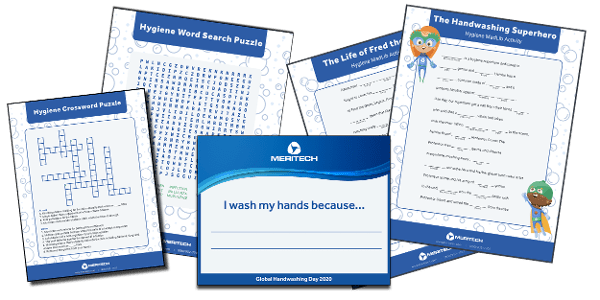Sustainable Solutions for Good Hygiene Practices in Food Industry
Today, businesses need to not only demonstrate their support of good hygiene but make it a priority for their for the safety and wellbeing of their employees and consumers. However, while having a sound hygiene response plan for the pandemic is a good measure of corporate social responsibility, it simply is not enough.
The threat of illness has always been a life or death issue for food manufacturing companies, so it’s important that solutions implemented to improve hygiene practices during this time at your facility are not reactive or band-aid decisions. Rather, these should be sustainable solutions that help build a better hygiene culture at your facility over time.
So what good hygiene practices do food manufacturers need to implement for a safer work environment for employees and consumers for the long-term?
Building a sustainable solution for long-term good hygiene practices in the food industry
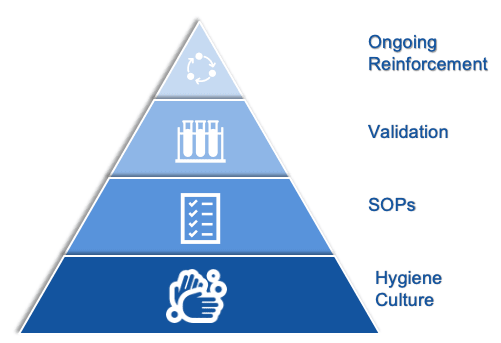
It is businesses’ corporate social responsibility to put hygiene first for the protection of their consumers and employees. For long-term good hygiene practices it’s key to focus on four key areas: hygiene culture, SOPs, validation and ongoing reinforcement.
Meritech’s Chief Technology Officer and Human Hygiene Expert Paul Barnhill discussed this topic in-depth at our recent virtual conference with QA Magazine, you can check it out here:
Hygiene culture is the foundation for good hygiene practices in the food industry
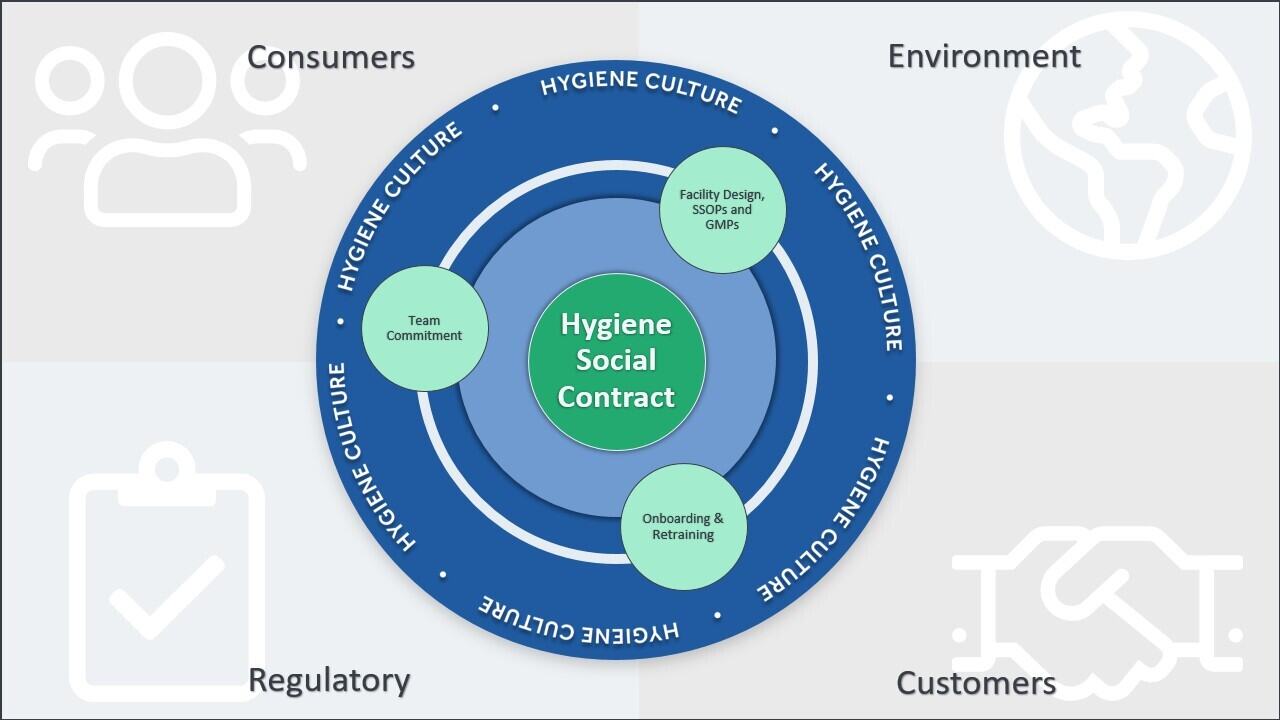 A hygiene culture is a unified mindset across the organization that puts food safety at the forefront of everything done within the business, both physically and mentally. If an effective hygiene culture is in place at the foundation of your plan, it’s easy to build sustainable good hygiene practices. This is because everything from the layout and design of a facility to how an employee thinks about their own personal hygiene, will all be considered through that lens of “does this match our hygiene culture?”.
A hygiene culture is a unified mindset across the organization that puts food safety at the forefront of everything done within the business, both physically and mentally. If an effective hygiene culture is in place at the foundation of your plan, it’s easy to build sustainable good hygiene practices. This is because everything from the layout and design of a facility to how an employee thinks about their own personal hygiene, will all be considered through that lens of “does this match our hygiene culture?”.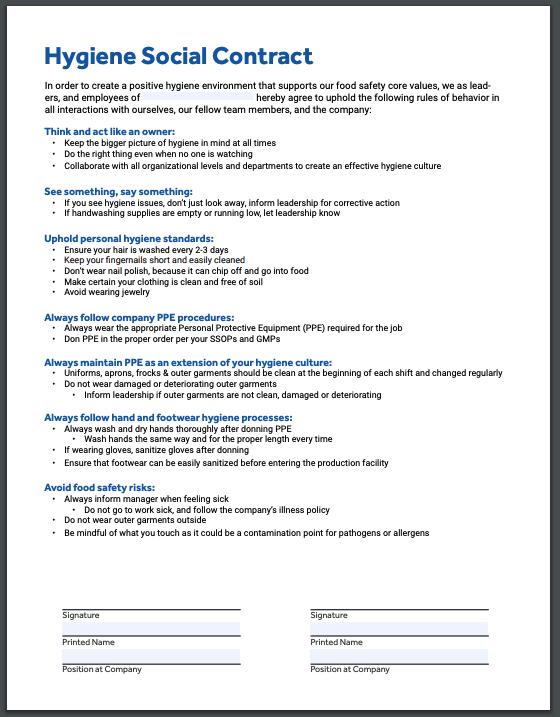
Nevertheless, creating a hygiene culture is a complicated task that requires every level of the organization from the executive leadership and middle management, to production team leaders and production team members to be on the same page when it comes to food safety. A hygiene social contract helps establish this mindset and ensures that the hygiene culture foundation is agreed upon by all members of the company, regardless of their position.
Learn more about creating a hygiene culture here.
Outline good hygiene practices for food safety in your SOPs
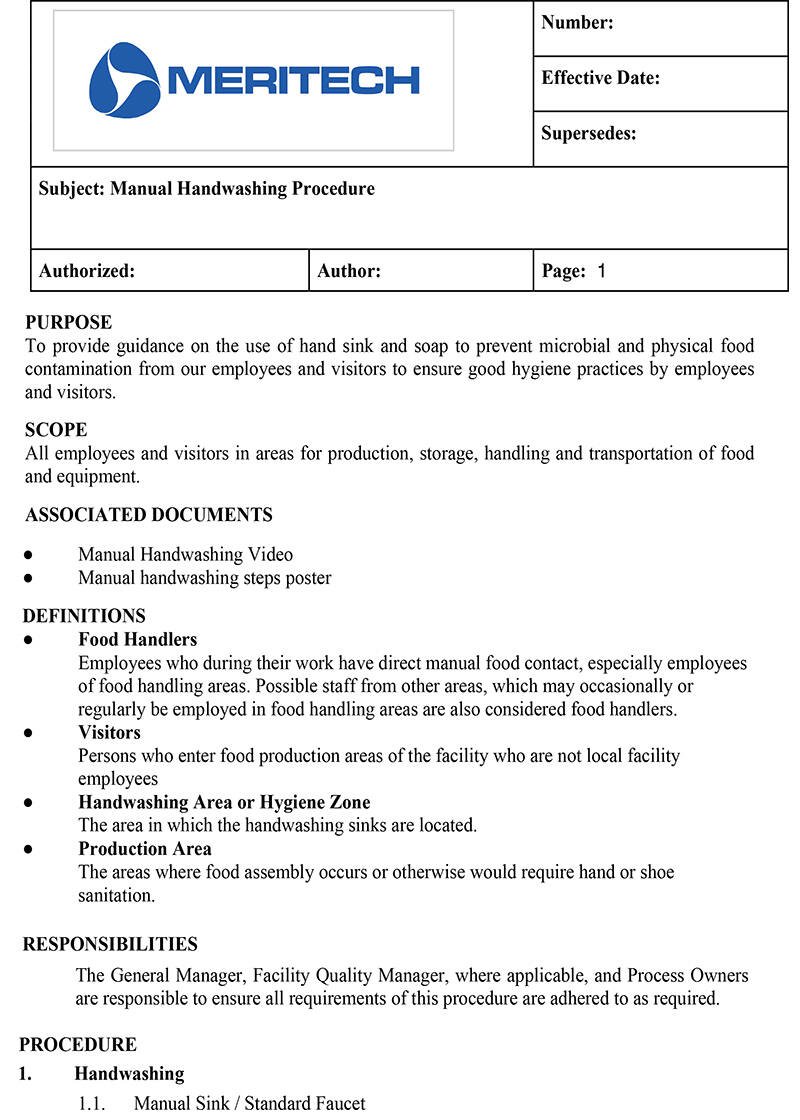
Having footwear hygiene and handwashing SOPs in place not only helps demonstrate a businesses’ corporate social responsibility but supports that organization’s hygiene culture by making hygiene a cornerstone of all processes. Hygiene SOPs build upon the hygiene culture and set the gold standard for hygiene practices at an organization. To support these SOPs create simple to follow procedures and guides to help staff understand the proper hygiene steps and reinforce these steps with posters throughout the hygiene zone.
Automation makes hygiene SOPs easier by removing some of the human variability that needs to be accounted for in these procedures. CleanTech® Handashing Stations make hygiene SOPs and compliance easier with automation that takes away the variability that needs to be accounted for in manual hygiene SOPs.
Download Manual and Automated Handwashing SOP templates here
Ensure food safety by validating your good hygiene practices
Once you start building your hygiene culture foundation and build upon it with footwear hygiene and handwashing SOPs, it’s key to ensure that all efforts are actually working to ensure food safety. There are several ways to validate your hygiene processes to make certain that they meet and exceed good hygiene practices and food safety standards:
- ASTM E1174 or "Glove Juice Test" Methodology
- Finger press / agar plate testing
- Swabs and test media
- ATP Testing
For over 30 years, Meritech has relied on the ASTM E1174 laboratory process to validate our CleanTech® systems for an FDA standard. Unfortunately, this process is hard to do in the field, so we build a a step by step white paper process for conducting ATP testing within your operation that you can download here. With automation, you’re already a step ahead as you remove the variability that comes with manual handwashing and can easily verify that handwashing compliance is being met with handwash cycle counters on the stations.
Ongoing reinforcement of good hygiene behaviors for food safety
Ongoing reinforcement is at the pinnacle of the process for building long-term good hygiene behaviors at your facility. This can’t be just a once a year event, instead footwear sanitation and handwashing best practices should be a part of huddle talks where you can also recognize hygiene superheroes amongst your team.
Safety days are another great way to reinforce good hygiene behaviors for food safety. Hygiene should be a cornerstone of safety day events where the “why” behind hygiene is reinforced with your team. Use activities like hygiene bingo to keep everyone involved in the safety day - this makes training easier and encourages greater commitment to good hygiene practices.
Download our safety day guide here!
Did you know?Global Handwashing Day is October 15th! This is a great day to have a safety day and reinforce good hygiene practices with your team. Download our handwashing day toolkit here - it’s full of fun activities and games to retrain team members on hygiene for food safety!
|
Overall, when it comes to building long-term good hygiene practices for food safety for your facility it’s 80% the attitude that you bring, and 20% is the process. Ensuring good hygiene is more than just checking a box or building SOPs, it’s really about believing that there’s a better way to address hygiene and that it’s your corporate social responsibility to lead the way and become a hygiene superhero for both employee and consumer well-being.

Sustainable changes for good hygiene practices won’t happen overnight, but with constant building and reinforcement of these 4 core areas, it will develop in time and create a hygiene culture for your organization that’s sustainable and will withstand any future pathogen or pandemic threats.
Interested in learning more about building this culture of hygiene excellence? If you’re ready to implement automated hygiene stations to help enable these long-term changes, contact us for more information!






